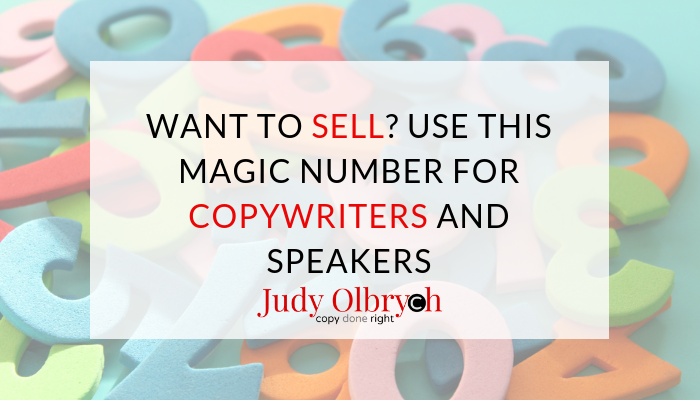Oprah, Presidents, and Ancient Romans know this secret of persuasion …
It makes your words memorable …
It amplifies your message …
And it makes your sales copy more effective ….
It’s the number THREE
… the minimal number of items in a list
… a relatively easy number of points to remember
… proven to persuade by both science and history
Keep reading to discover specific ways this magic number makes messages more memorable, effective, and compelling.
A Success Secret Throughout History
The tricolon comes from the ancient Greek words τρία, meaning three, and κῶλον, meaning clause.
This rhetorical device consists of a series of three words or phrases which are parallel in structure, length, and rhythm.
Simon Lancaster, speechwriter for CEOs and members of Tony Blair’s cabinet, explains how tricolons make you more credible, convincing, and compelling.
Where have you seen or heard a tricolon? Take a look:
Life, liberty, and the pursuit of happiness
Thomas Jefferson, The Declaration of Independence
Be sincere, be brief, be seated
President Franklin Delano Roosevelt
VENI, VIDI, VICI
Julius Caesar
Liberté, égalité, fraternité
Motto of the French Revolution
Stop, Drop, and Roll
Every Fire Safety Program My Kids Ever Attended
How will a tricolon enhance your next headline, email, or lead?
Words that Stick
World Champion of Public Speaking Craig Valentine uses the Rule of THREE to make his educational presentations more effective.
After replacing his “7 Secrets to Speaking Success” workshop with a three-point structure, Valentine found his audiences were better able to organize and remember points from the training.
Here’s his short post on the rule of three. https://craigvalentine.com/be-funny-and-clear-by-using-the-rule-of-three/
How will the Rule of Three strengthen your next presentation, course, or webinar?
Charming or Alarming?
Kurt Carlson at William and Mary’s Mason School of Business (Go Tribe!) and Georgetown University and Suzanne Shu at UCLA discovered that THREE beats FOUR when it comes to winning over your prospect.
When Three Charms But Four Alarms: Identifying the Optimal Number of Claims in Persuasion Settings (Journal of Marketing, Jan 2014), presents research on how consumers react to persuasive claims.
In one study, participants were asked about a breakfast cereal and a friend’s dating life:
Is that crunchy cereal really new and improved?
Should your friend get back together with her old boyfriend?
The results showed that with a persuasive message, two positive claims were better than one and three worked better than two.
However, at four claims, the prospects began to see ALL the claims with skepticism.
When the cereal packaging read, “Healthier, better tasting, crunchier, and with higher quality ingredients,” participants were more likely to see the cereal company’s primary motivation as making a sale as opposed to informing them about the product.
With four claims about the ex-boyfriend, participants viewed the dating conversation as an attempt to convince the listener that “John is worth dating” rather than to tell “what John is like as a person.”
A second experiment found three claims was a charm for 5 diverse targets: cereal, restaurant, shampoo, ice cream store, and politicians. The conclusion: “impressions of the objects on dimensions related to the claims peaked at three claims.”
Where can you test 2, 4, or 5 claims in your existing copy against a group of three?
To your marketing success,
Judy Olbrych

